JP Morgan Chase Analysis
21 Pages6076 Words61 Views
ECONOMICS OF BANKING AND FINANCE (226ECN)
Added on 2020-04-15
JP Morgan Chase Analysis
ECONOMICS OF BANKING AND FINANCE (226ECN)
Added on 2020-04-15
ShareRelated Documents
JP Morgan Chase Analysis 1JP Morgan Chase Analysis
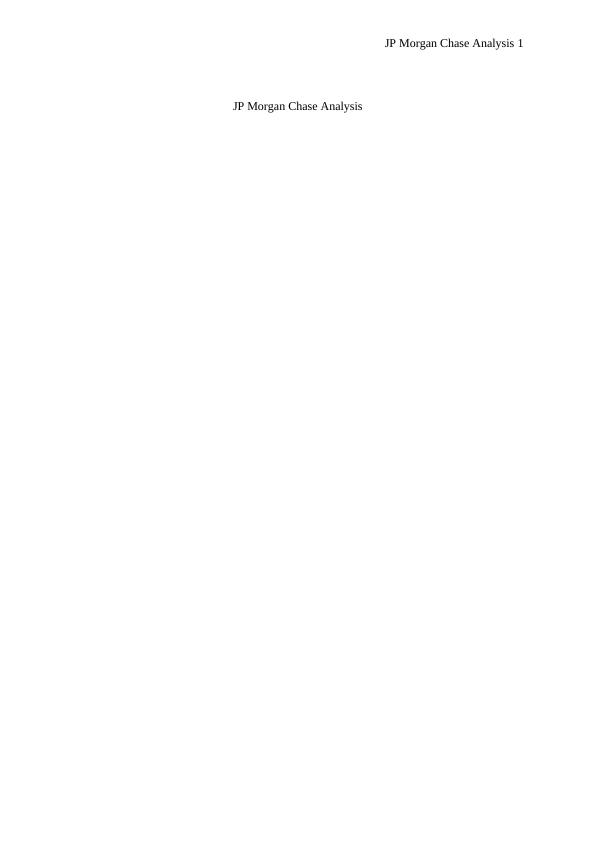
JP Morgan Chase Analysis 2Table of ContentsIntroduction................................................................................................................................31. Background of JP Morgan Chase and its two key roles in terms of its contributions to the US financial system....................................................................................................................32. Problems of Debt Finance Provided By Financial Surplus Unit In Comparison to Financial Deficit Unit.................................................................................................................................43. Main Changes to the Capital Adequacy, Liquidity and Leverage Requirements as Stipulated by Basel III and Impact of such Changes on JP Morgan’s Financial Conditions.....64. Asset Securitization and the Reasons Why Different Financial or Banking Institutions Might Wish to Securitize.........................................................................................................105. Implications of the 2008 financial crisis on JP Morgan’s financial performances shortly after the crisis...........................................................................................................................13Conclusion................................................................................................................................16REFERENCES.........................................................................................................................18
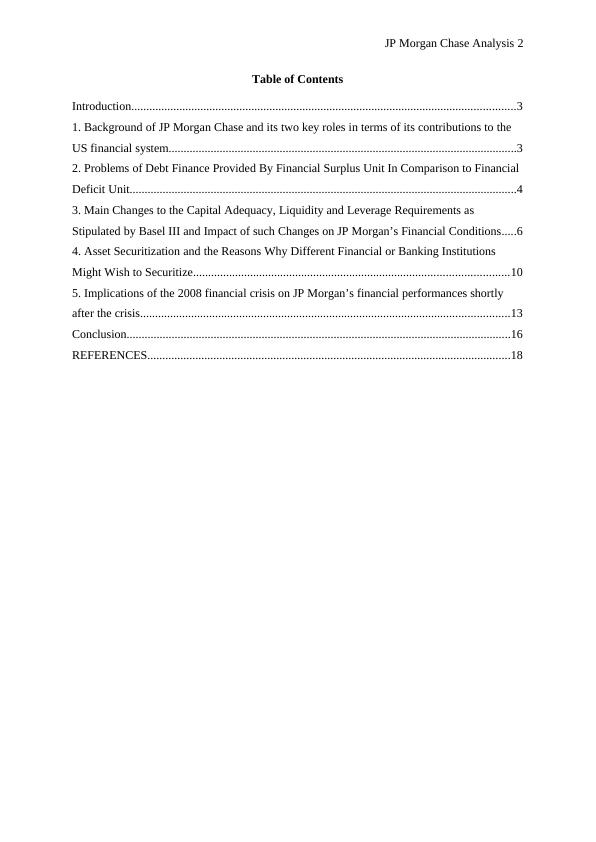
JP Morgan Chase Analysis 3JP Morgan Chase AnalysisIntroductionThe report is about a detailed analysis of JP Morgan Chase. It comprises of a critical discussion of the key roles this banks plays in contributing to the nation’s financial system. Inaddition, it presents some of the problems associated with relying on debt financing provided by financial institution that is financially surplus compared to the one that is financially deficit. The report also presents explanations of the main changes to the capital adequacy, liquidity and leverage requirements as stipulated by Basel III as well as some of the likely impact of these changes on JP Morgan Chase’s financial conditions. Besides, it presents explanation of asset securitization process and the reason the bank would wish to securitize. Finally, it present a detailed discussion of the main implications of the 2008 financial crisis on JP Morgan Chase’s financial performance shortly after the crisis as well as some of the measures implemented by the US governmentto calm its financial markets during that time.1. Background of JP Morgan Chase and its two key roles in terms of its contributions tothe US financial systemJP Morgan Chase is one of the American multinational financial and banking services firm based in the New York (JP Morgan, 2016). It is usually amongst the largest financial or banking institutions across US and sixth largest across the globes by assets with a total assets of around $2.5 trillion. It is also the second most valuable firm across the world by market capitalization after commercial and Industrial banks of China (JP Morgan, 2016). In other words, JP Morgan Chase is one of the main providers of the financial and banking service (JPMorgan, 2016).

JP Morgan Chase Analysis 4It provides numerous financial and banking services to governmental, institutional and corporate customers within the US and internationally. Further, it provides non-interest bearing deposits, savings accounts, interest-bearing time deposits as well as market deposits (JP Morgan, 2016). In addition, it offers clients loans such as home equity loans, lines of credits, residential mortgages, business banking loans, auto loans, as well as other loans. In other words it offers prime mortgage loans, credit card loans, payment option loans as well aswholesale loans to numerous clients (JP Morgan, 2016). To be more specific, JP Morgan Chase is the world leader in banking and financial services, providing solutions to the global most significant governments, institutions and corporations in over 100 nations (JP Morgan, 2016). In other words, JP Morgan Chase is the largest bank and chief provider of financial and banking services across US by profit, market value, sales and assets. It serves over 1 million clients, small enterprises, and many prominent institutional, governmental and corporate customers (JP Morgan, 2016). It gives around $200 million every year to the non-profit firms across the globe. It also leads volunteer services events for the personnel in the local communities by using numerous resources including the one that stem from the access to capital, global reach, economies of scale and expertise. JP Morgan Chase invests in its partners and communities with the local firms to offer creative solutions which are said to respond to the neighbourhood development needs. Its leading expertise and scale assist in reducing environmental risks while producing new opportunities in order to make more sustainable worldwide economy (JP Morgan, 2016). 2. Critically explained the Problems of Debt Finance Provided by JP Morgan Chase with those parties who are a Financial Surplus Unit in Comparison to Financial Deficit Unit
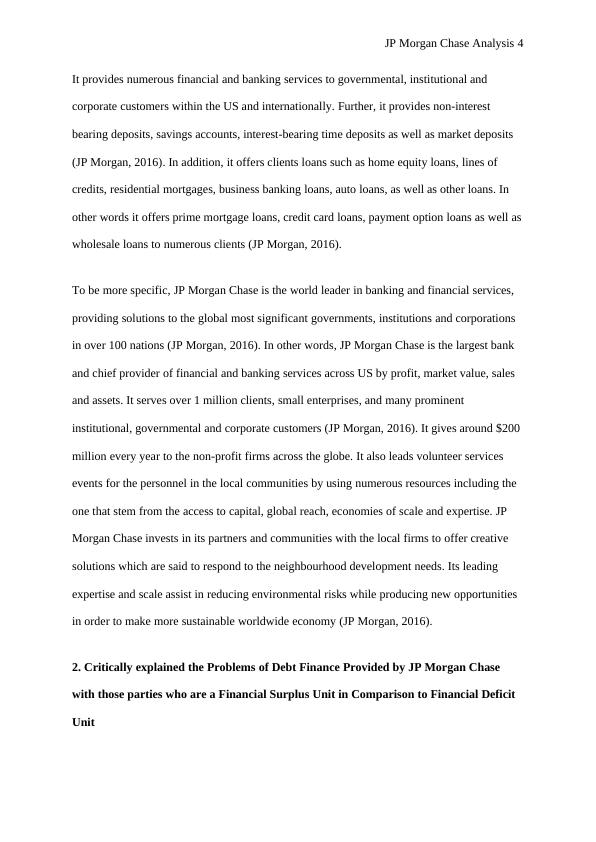
JP Morgan Chase Analysis 5Provision of debt finance by JP Morgan Chase to the surplus units as well as deficit units poses some problems to the bank (Bohn, 1998). For instance, the act of providing debt finance to financial surplus unit posed numerous issues on maturity mismatch where by it is forced to provide a loan with minimal or short maturity period. This was hectic to the bank since given the fact that financial surplus units was having some leverage issues due to the 2008 financial crisis, these units would struggle to meet their short maturity debts obligations provided by JP Morgan Chase. Such would not occur if the JP Morgan Chase decides to provide debt to the financial deficit unit that offers long maturity debts (Demetriades & Andrianova, 2004). In addition, JP Morgan Chaseprovision of debt finance to financial surplus unit would be challenging due to size mismatch whereby there are only small funds available being offered to these banks. For instance, JP Morgan Chase action in providing a loan to one of the banks in US posed a major problem since it was hectic to get the actual amount it required to finance its operations as compared to the amount it provided to financial deficit unit that are large (Demetriades & Andrianova, 2004). In addition, JP Morgan Chaseproviding debt finance to units with those parties who are a financial surplus unit would be hectic since it demands the bank to have as high return as possible (Bohn, 1998). Further, providing debt finance to parties that are financial surplus would be challenging since it would necessitate the bank to charge relatively high interest rates which would make the deficit units unable to repay the loans (Bohn, 1998). This would force JP Morgan Chase to get some collaterals in order to safeguard its loans. Nonetheless, where suchrisks are of greater concern, there are other risks involved such as risk of bankruptcy. This means that if the loans are on fixed rates, the US Fed act of imposing high interest rates would benefit the depositors but JP Morgan Chase would be forced to strike the balance in between the returns and risks to remain competitive (Petersen & Wiegelmann, 2014).
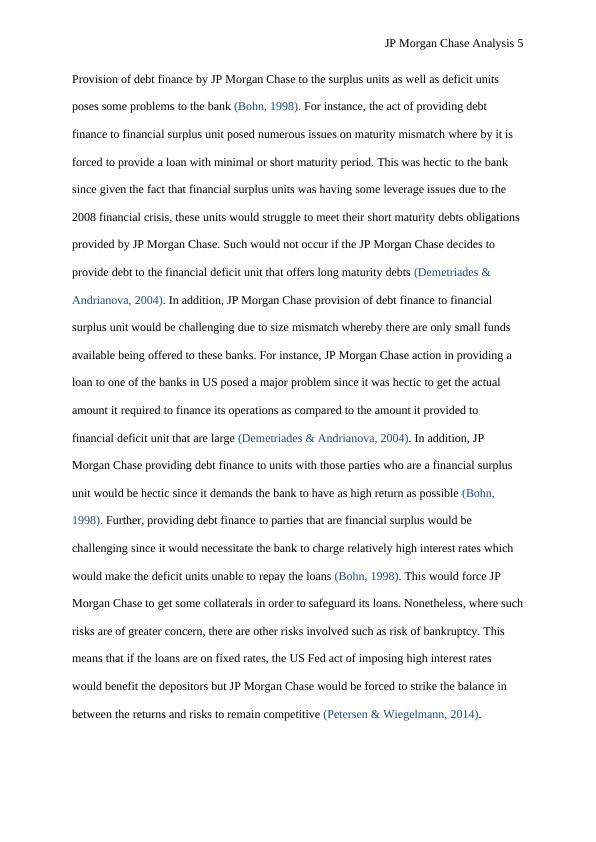
JP Morgan Chase Analysis 63. Main Changes to the Capital Adequacy, Liquidity and Leverage Requirements as Stipulated by Basel III and Impact of such Changes on JP Morgan’s Financial Conditions Basel III is usually a sequence of measures designed in repairing and augmenting Basel II accord (Ojo, 2013). This adjunct addresses the issues of the economic pro-cyclicality and gives suggestions on the means of mitigating such issues through increase in capital charges when country’s economies overheat as well as when capital charge reduces in the economic contractions (Kasekende, Bagyenda & Brownbridge, 2011). Basically, the Basel III is far much stricter and complete than the Basel II. Some of the reforms recommended in the Basel III include the five facets for enhancing capital, raising quality, transparency and consistency of capital base, enhancing risk-based capital needs with leverage ratio, enhancing risk coverage, promoting country-cyclical buffers and reducing pro-cyclicality as well as addressing interconnectedness and systematic risks (Ojo, 2013). The Basel III comprised of some measures that are mainly targeted at improving the value and capacity of capital within the economy, aimed at refining loss-absorption ability in both the liquidation and going concerns setups. By retaining a minimum capital competence of 8%, Tier 1 was increased to 6% with equity postulated at 4.5% (Jayadev, 2013). These new concepts are for countercyclical capital bumper and capital conversion bumper which ensured that financial institutions are capable of absorbing the losses without any breach to the minimum capital requirements and were capable of carrying their operations even during economic crisis without deleveraging (Bhowmik, 2014).Table 1: Regulatory Capital prescriptions under Basel III
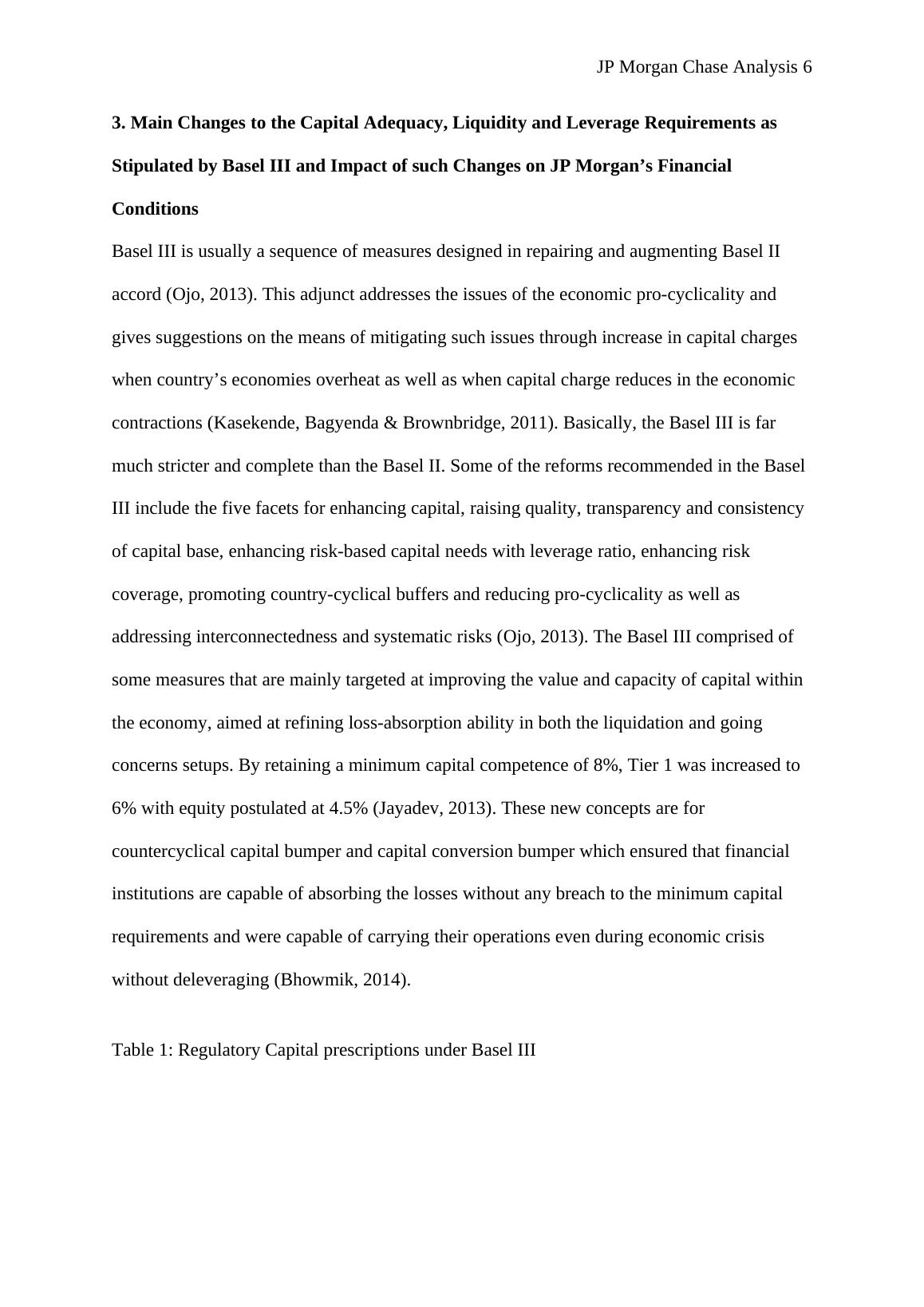
End of preview
Want to access all the pages? Upload your documents or become a member.
Related Documents
Assignment Finance: Financial Operationslg...
|7
|1631
|70
Impact of Securitization on Canadian Financial Market and Global Financial Crisislg...
|6
|1596
|202
Economics of Banking and Finance: Roles of Banks, Debt Financing, Basel III and OCBClg...
|14
|4810
|228
Credit Rating Analysis on Citi Group using CAMEL Analysislg...
|18
|3778
|344
BANK CAPITAL ADEQUACY-BASEL II AND BASEL III.lg...
|15
|2590
|12
Factors That Led Up To the Global Banking Crisis 2007/09lg...
|4
|724
|62
